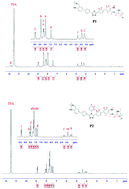Polyazomethines based on oxadiazolyl or 1,2,4-triazolyl groups: synthesis and hole-buffering application in polymer light-emitting diodes†
Abstract
Balance in charge carriers is a prerequisite for obtaining high emission efficiency in polymer light-emitting diodes (PLEDs). This paper reports the synthesis of two new polyazomethines P1 and P2 with electron-withdrawing 1,3,4-oxadiazolyl and 1,2,4-triazolyl groups, respectively, in the main chain and their successful application as hole-buffer layers (HBLs) in PLEDs to enhance charge balance and emission efficiency. P1 and P2 reveal excellent thermal stability (Td > 350 °C) because of their rigid main chain structure. The HOMO levels of P1 (−5.37 eV) and P2 (−5.33 eV) are lower than the −5.0 eV of the emissive SY-PPV layer to reduce hole transport. Multilayer PLEDs (ITO/PEDOT:PSS/HBL/SY-PPV/LiF/Al) have been successfully fabricated, using spin-coated P1 or P2 as the hole-buffer layer. The maximum luminance and maximum current efficiency of the blank device (12 352 cd m−2, 2.3 cd A−1) were significantly enhanced after inserting P1 (15 503 cd m−2 and 4.91 cd A−1) or P2 (20 058 cd m−2 and 8.08 cd A−1) as the HBL. Current results indicate that both P1 and P2 are promising hole-buffering materials applicable in optoelectronic devices.



 Please wait while we load your content...
Please wait while we load your content...